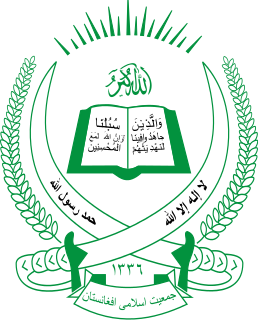 W
WThe Islamic Unity of Afghanistan Mujahideen, also known as the Seven Party Mujahideen Alliance or Peshawar Seven, was an alliance formed in 1988 by the seven Afghan mujahideen parties fighting against the Soviet-backed Democratic Republic of Afghanistan forces in the Soviet–Afghan War. The alliance sought to function as a united diplomatic front towards the world opinion, and sought representation in the United Nations and Organisation of the Islamic Conference.
 W
WHezb-e Islami Khalis is an Afghan political movement under Maulawi Khalis, who separated from Gulbuddin Hekmatyar's Hezb-e Islami and formed his own resistance group in 1979. The two parties were distinguished as Hezb-e Islami Gulbuddin and Hezb-e Islami Khalis, after the names of their respective leaders.
 W
WThe Hezb-e-Islami Gulbuddin, also referred to as Hezb-e-Islami or Hezb-i-Islami Afghanistan (HIA), is an Afghan political party and former militia, founded and led by Gulbuddin Hekmatyar.
 W
WHezb-e-Islami, meaning Islamic Party is an Islamist organization that was commonly known for fighting the Communist Government of Afghanistan and their close ally the Soviet Union. Founded and led by Gulbuddin Hekmatyar, it was established in Afghanistan in 1975. It grew out of the Muslim Youth organization, an Islamist organization founded in Kabul by students and teachers at Kabul University in 1969 to combat communism in Afghanistan. Its membership was drawn from ethnic Pashtuns, and its ideology from the Muslim Brotherhood and Abul Ala Maududi's Jamaat-e-Islami. Another source describes it as having splintered away from Burhanuddin Rabbani's original Islamist party, Jamiat-e Islami, in 1976, after Hekmatyar found that group too moderate and willing to compromise with others.
 W
WThe Islamic Dawah Organization of Afghanistan is a political party in Afghanistan led by Abdul Rasul Sayyaf. Founded in the early 1980s as the Islamic Union for the Liberation of Afghanistan, it was originally an attempt to bring unity amongst Islamist opposition forces in Afghanistan. However, the creation of the new umbrella organization effectively created a split and the organization became a political party of its own. The organization was part of the 'Peshawar Seven', the coalition of mujahedin forces supported by the United States, Pakistan and various Arab states of the Persian Gulf in the war against the PDPA government and Soviet forces. Through the financial aid received from Saudi sources, the organization was able to attract a considerable military following. Arab volunteers fought in the militia forces of the organisation.
 W
WJamayat-E-Islami, sometimes shortened to Jamiat, is a Muslim political party in Afghanistan. The oldest Muslim political party in Afghanistan, it was originally formed as a student political society at Kabul University. The majority of the party are ethnic Tajiks of northern and western Afghanistan. It has a communitarian ideology based on Islamic law. During the Soviet–Afghan War and the following Afghan Civil War against the communist government, Jamiat-e Islami was one of the most powerful of the mujahideen groups. Burhanuddin Rabbani led the party from 1968 to 2011, and served as President of the Islamic State of Afghanistan from 1992 to 2001.
 W
WNational Islamic Front of Afghanistan is a political party in Afghanistan. It has been led, since its founding, by members of a prominent Sufi family, the Gailani. It is primarily a Pashtun party, followers of the Sufi holy man Pir Sayed Ahmed Gailani have a reputation for moderate thought and the traditional mystical and introspective religious currents that characterize Sufism in that sect.
 W
WThe Shura-e Nazar was created by Ahmad Shah Massoud in 1984 at the northern provinces of Takhar, Badakhshan, Balkh and Kunduz, during the Soviet-Afghan War. It comprised and united about 130 resistance commanders from 12 northern, eastern and central regions of Afghanistan. Though operating autonomously, Shura-e Nazar was technically an offshoot of Rabbani's Jamiat-e Islami and hence operated within the framework of the Peshawar Seven against the Soviet-supported Democratic Republic of Afghanistan.